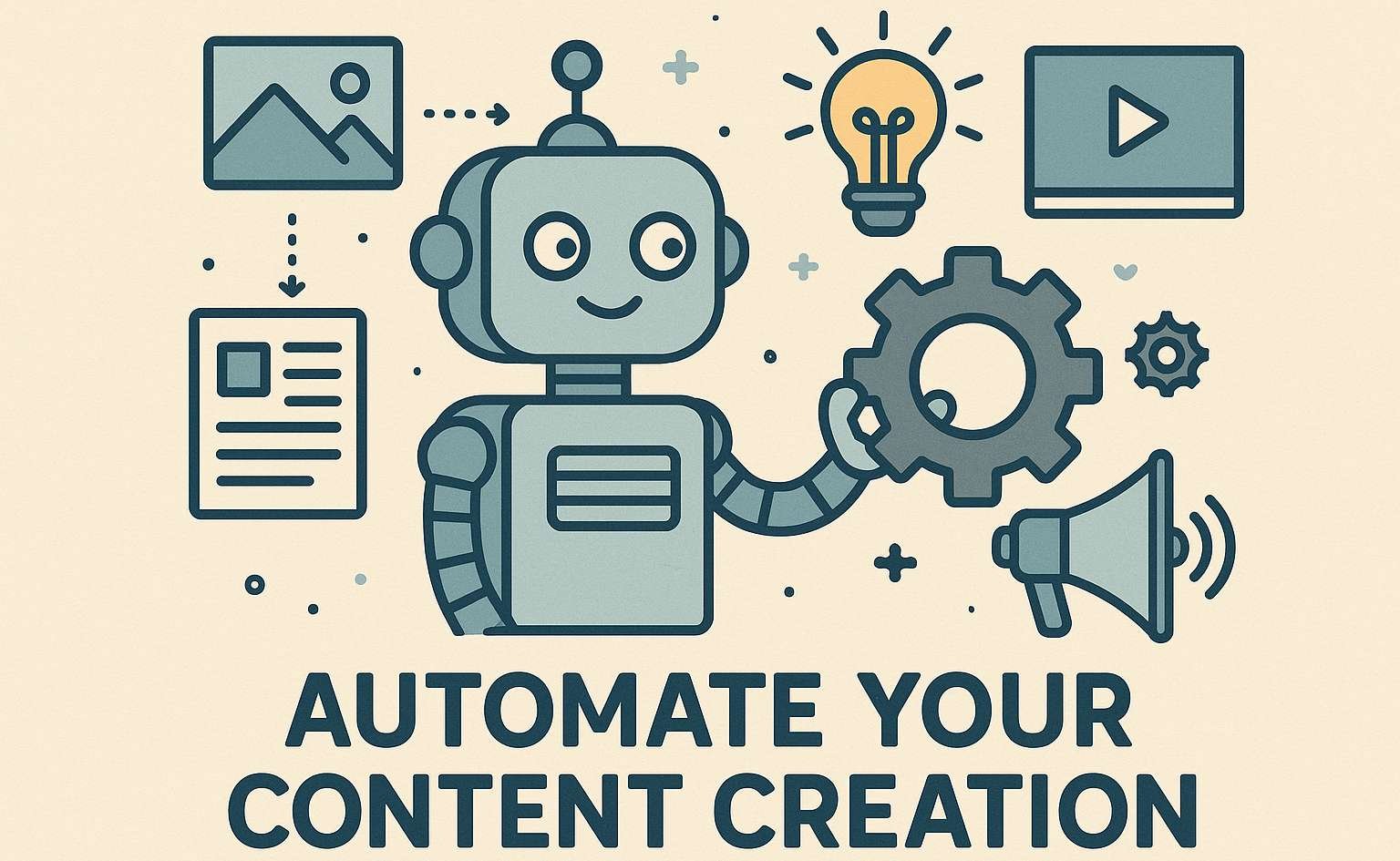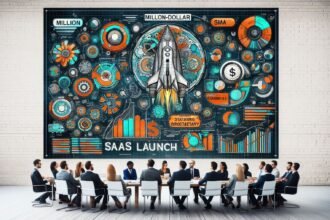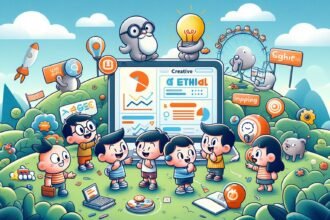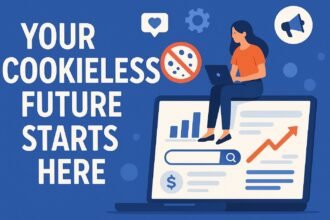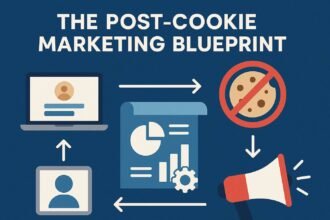Embarking on Your Journey into AI-Powered Content Creation
Artificial Intelligence (AI) is playing an increasing role in content creation. Advances in AI technologies—including language analysis, text generation, and image manipulation—empower content creators to work smarter and faster. Although AI cannot replace human creative instincts, it can help refine content strategies, make clients’ wishes clearer, and even reduce human input in various ways.
For some content creators, the notion of using AI to write or optimize content is a source of apprehension. However, the reality is that AI enables more people to share their unique stories and perspectives. When leveraged responsibly, AI can increase overall originality and diversity in content creation and help groups and individuals tell their own stories.
Understanding Content Creation
Content creation is the process of researching, planning, writing or filming, and publishing content. However, it does not end with publishing—promotion and analysis of published content are fundamental to the overall content creation process. Optimizing content for search engines and helping authors and brands reach their audience are essential considerations that directly influence success. Just as content creation involves more than simply sitting down to write, assistance at every step can help content make a meaningful impact. Artificial intelligence, which aids in all aspects of content research, creation, optimization, delivery, and analysis, can be a helpful companion along the way.
Artificial intelligence is a machine’s ability to imitate cognitive functions that humans associate with other human minds, such as learning and problem solving. AI collaborates with content creators and helps them with tasks like researching, writing, or editing content. The various forms of AI include dedicated research agents, natural language processing, machine learning algorithms, generative adversarial networks, and many others. When it comes to content creation, usage is concentrated in natural language processing, machine learning algorithms, and generative adversarial networks.
Historical Context of AI in Creative Fields
The field of content creation has been enriched by artificial intelligence only since the early 2010s, thanks to the development of powerful deep learning algorithms and cheap yet powerful computers. Nevertheless, creative AI has a much longer history spanning all the way back to the 1950s. Early artificial intelligence in creative fields was concerned with utilitarian ideas, but their advancement toward creativity became more visible during the 1970s. With a firm footing in the 1980s, analysis and synthesis methods of artificial intelligence for creativity started to emerge in the 2000s. As creativity is a multidimensional concept, the success of AI in the field of creativity forms a basis for the future of artificial general intelligence and testing the limits of similarity, originality, and novelty.
Ten-years-old children can nowadays carry out several tasks within the area of content creation by utilizing artificial intelligence, through creative applications such as DALL-E. Nevertheless, even professional content creators take advantage of the time-saving and creativity-boosting features AI provides. AI can function as a co-author during the whole process of content creation, starting with picking ideas and carrying out preliminary research, and then organizing and outlining content, writing, editing, optimizing for SEO, creating visuals, distributing content to multiple platforms, and finally analyzing the performance and reception of content. However, AI cannot be a complete replacement for human creativity, perspectives, and critical thinking. When content creators use artificial intelligence in a responsible, mindful, and sensible way, it is easy to fall in love with the workflow it creates.
Types of AI Technologies Used in Content Creation
Three main types of AI are used for content creation.
Natural language processing (NLP) focuses on the interaction between computers and people through language. Machine learning algorithms identify patterns in data and then use these patterns to predict future outcomes and trends. Generative adversarial networks (GAN) consist of a generator that creates images and a discriminator that reviews them, evaluating whether they are artificial or genuine. The generator then learns to produce increasingly realistic images as a result.
The Playbook for Creating Content with AI With an understanding of the technologies now in use, precise instructions show exactly how to use artificial intelligence to supercharge each stage of content creation, including research, outlining, writing, editing, optimizing for search engines, crafting images, video, and illustrations, distributing and promoting content, analytics, and user feedback.
Natural Language Processing
Natural language processing (NLP) is the discipline of figuring out what language means — and also how to interpret, manipulate, and generate natural human language.
Natural language processing is what allows you to talk to Alexa or Google Assistant, and it’s a key part of various AI content-creation capabilities — from helping you conduct research to outlining ideas and generating a draft sheet you can then iterate on.
Machine Learning Algorithms
Machine learning algorithms analyze historical data to recognize patterns within that data. They make decisions or predictions based on that information and can continuously learn to improve their accuracy and relevance by analyzing new data. Deep learning is an advanced form of machine learning using artificial neural networks designed to imitate the human brain. This approach processes large amounts of data, creating a set of rules to help make complex and very accurate decisions. Both machine learning and deep learning can operate in supervised, unsupervised, or reinforcement modes depending on the problem and dataset.
Supervised learning involves training the algorithm using a labeled dataset, helping the machine predict outcomes for new, incoming data. Unsupervised learning uses an unlabeled dataset, enabling the algorithm to discover structure or patterns on its own. Reinforcement learning is a sequential approach where the algorithm learns by receiving rewards or penalties based on its actions in a given environment.
Generative Adversarial Networks
(GAN) represent a recent development in AI that has created a great deal of excitement in the Artificial Intelligence community. GANs consist of two neural networks architected in competition with one another: the Generator and the Discriminator. The Generator is charged with repeatedly generating new content that resembles a given reference set. The Discriminator needs to determine whether new content was created by a human or the Generator. The Generator continues creating until it can fool the Discriminator repeatedly. GANs are primarily used in visual content creation. The AI generative art tools discussed in “AI Tools for Content Creators” rely on GANs, and practitioners first include AI artwork when covering “Using AI for Visual Content” in “The Playbook for Creating Content with AI.” When these tools enter the market, it seems that the Discriminator primarily improves.
Many aspects of GANs are still object of active research and development. Deepfakes, synthetic yet convincing audiovisual clips, rely on this architecture to generate realistic visual content. That non-digital example of GAN-created content demonstrates the potential of AI, especially when its applications are combined. Collectively, the described technologies enable the creation of synthetic influencers, entirely designed by Artificial Intelligence.
The Playbook for Creating Content with AI
Over the last few years, authors have reported that AI functions—the ability to select, arrange, modify, refine, or generate content that is novel or creative—can help content creators brainstorm ideas, create outlines, write, and execute a winning distribution strategy full of images and video. The interplay between content creators and AI can be explained through a series of tasks on all fronts of content creation. First, use AI to research, brainstorm, and outline content that will help attract leads or ease customers through their journey. Next, write the content with as much help or interference from the machine as you like. Then, use an AI editor to elevate the writing through improved grammar and clarity while maintaining personality and style. AI can also augment the content creator’s search engine optimization (SEO) strategy. Finally, use AI to create images and video for social media, blog posts, eBooks, and the company website.
AI is also a strategic partner that can identify where and when―at what hour and minute―content should be distributed, and in the hands of a big company, its AI can evaluate the content’s engagement, success, and return on investment (ROI). The benefits of AI extend throughout the content creation workflow: discovering content topics, generating text, enhancing existing content, creating visual media, distributing content effectively, and analyzing performance feedback. Some of the most common spaces where AI considerations have emerged include creating social media content and trends, developing and executing a blog content strategy, generating images and videos, distributing content to the public effectively, enhancing the user experience, providing feedback along the way, and increasing accessibility.
Researching Topics and Keywords: Finding the Gold
Much of the Playbook for Creating Content with AI depends on Natural Language Processing and is therefore covered in the earlier section Natural Language Processing. Keyword research is a great place to get started. There are many affordable tools for identifying high-volume topics and keywords with a low competitive level. Narrowing your focus to a specific keyword is important when creating content designed to get discovered on the web. Google is just one algorithm-driven search tool. Content creators identify keywords and phrases people are most likely to type into a search engine and then build content around those keywords.
Machine Learning Algorithms power your SEO efforts much the same way that Natural Language Processing powers the writing process. After the Playbook’s last step, Analyze Results, your machine learning algorithms begin looking for correlations between your audience’s demographic data and the content they’re actually reading. It’s a feedback loop. The same data that led you to write the content is now being reversed engineered to give you greater insight into who’s really reading it. When the findings illuminate previously overlooked or untapped sections of your audience, keyword and topic research begins again.
Making an Outline Like a Pro
Use Artificial intelligence for research and then identify the best points and sub-points for each. Writing an outline is the secret to success for writing entire articles. You must always write an outline. It is the roadmap that will keep you on track and help you determine what your words should say.
Artificial Intelligence can also help you write an outline. First, ask it to generate a few topics for an article and to put them in order for you. Secondly, ask it to list the main points and sub-points of each sub-topic. Always review and edit AI-generated content. Learning how to outline like a pro takes work, but once you’ll master it, you will be miles ahead of the competition.
Writing with Style
Natural Language Processing, Police Confidential, and the Associated Press: A Content-Creation Playbook Netlore. As a content creator, you understand the process. Start by researching a topic to develop a good outline. Use the outline in the first draft of the post, followed by editing to sharpen the point or improve clarity. Post on a blog or share on social media. You want to do SEO and write titles or descriptions that’ll help drive traffic to the post. To accomplish that, you’ll use various tools for image creation, writing, and editing.
Built-in tools within the writing apps can provide some assistance, but they can’t automate the research and outline steps. Also, generally, the title creation, tag definition, and description writing (for social media posts or blogs) occur at the end of the creation process. The playbook puts these steps first of each creation area. Think of it as a workflow that will help you be more effective, efficient, and creative. Use the process to create new content or optimize existing content.
Natural Language Processing Power
and
Machine-Learning Algorithms: The Association for Computational Linguistics (ACL) formally approves titles for its conferences, workshops, and events. Its website offers a list of past and upcoming meetings, abstracts, and the Best Paper or Student Paper Award. It would be useful to have a concise summary highlighting the main points and ideas of the article. Summarization tools that use machine learning can identify the informative sentences within a document and generate an efficient, coherent summary. Other AI tools allow users to ask questions about the content that they did not specifically research in the document.
Improving Grammar and Style
Artificial Intelligence can improve grammar and style in many languages. AI can proofread for correct grammar and spelling. AI can suggest expanding or shortening content. When AI suggests expanding content, it can add more detail or supporting arguments. When AI suggests shortening content, it may paraphrase to be more concise.
Incorporating AI can help maintain a consistent tone. AI can tailor the tone to be more formal, colloquial, positive, or negative, depending on the context. Programs exist that aid in improving grammar and style, each with different operational methods.
SEO Optimization: Moving up the Google Ladder
Whether blog or TikTok, YouTube or Podcast, content creation has three types of goals: Inform, educate and entertain. At the same time, the content creator at the top of their game wants to build an audience and increase their influence. After all, this is why they committed to the months, years, or decades it takes to get to the top of their creative craft. Content is king, and the content creator wants users to find, engage and be entertained by the content. That requires optimizing content for discovery. Every creator wants to optimize their content.
Information about the optimal SEO for a given subject, keywords with the highest value, which hashtags are trending, and performing metadata are constantly changing. AI is excellent at gathering information available across the web and synthesizing it for easy consumption. By learning the keywords, queries and subjects that are trending, a content creator or the AI system can optimize the title, video descriptions, episode notes or hashtags associated with their content. Before publishing, ask the AI to evaluate the content for SEO and make recommendations. Before sharing, especially on Twitter, have the AI identify relevant users and suggest tweets that increase engagement. Follow the same process when sharing content on LinkedIn.
Visual Content: Easy to Make Eye Candy
They say a picture is worth a thousand words, so a big question for AI and content creation is whether artificial intelligence can produce visual content — images, videos, and GIFs. These days, the answer is an emphatic YES. Below, let’s look at how AI can help content creators produce visual content that captures eyeballs.
Writing isn’t the only form of content creation and curation that artificial intelligence can help with. Images and videos are essential in creating user engagement, as well as search engine ranking. In many cases, a picture with a clever caption is the whole message — think of the famous “Keep Calm and Carry On.” Yawn. Try a possibly NSFW “eff off” message from the very same template. Add images to micro-blog post, and watch the buzz grow. Captions are equally important for images. They can make or break how the image is perceived. Then there’s original content. If you use images from others, say, by Googling for open and free photos, you’re treading a legally ambiguous path — not to mention that it’s hard to come up with consistent imagery that fits your brand. Top quality dogs and cats don’t always show up together in various blogs, right? The Tartans make good use of photos in their articles, but can you find a pattern in their usage? Looking for something more focused? There are services like Unsplash, Burst, and Pixels that have millions of photos covering a wide variety of topics. But as with anything that’s popular, if everyone’s using it, your images are little different from the rest of the crowd.
Distribution: Spreading the Word
Generating high-quality content on a regular schedule is a great start, but broader distribution of your content involves planning where it should go and how best to present it. Social media channels are the obvious publishing options, but e-mail newsletters and website pages may be equally important.
Brainstorming all possibilities and prioritizing categories is best handled by a simple outline. AI-powered research services can jump-start this process by retrieving and on-screen summarizing a wide range of industry discussions that reveal interesting publication strategies, specialized platforms, promotion approaches, and similar information. You paste the relevant content into a new prompt so the AI can sketch a general outline, which you then review, expand, and order. Summaries of audience segmentation and distribution segments—plus key points from each segment—should also be included.
Analytics: Keeping Track of Your Wins
Understanding your content’s performance is key to producing more of what works. AI makes analyzing trends, user activity, and content performance easier—and something to do more often. In addition to making creation easier, it helps satisfy a marketer’s constant need for more information. As you distribute content, AI can track metrics such as the number of shares, comments, reactions, profile visits, and clicks—and then suggest optimal posting times, recommend hashtags, and even narrow the audience for boosted posts.
The more people engage with your content, the smarter your AI tools get. This amplified (and automatic) feedback loop helps segment audiences and provides fresh content ideas. It can also identify and react to unexplored content gaps or position your content to fit a user’s budget, goals, or audience. While the future of AI content creation will likely include the ability to generate content entirely from a spreadsheet, right now, these AI feedback tools offer a glimpse of that capability. They help content creators—and the broader business—get smarter about content performance, act more quickly, and create attractive experiences for their audiences.
Benefits of AI in Content Creation
AI in creative fields can help both organizations and individuals. For instance, AI often speeds up tasks by automating repetitive and tedious work — like generating a first-draft outline based on research and a prompt (e.g., writing a blog post about AI for content creation) — allowing busy humans to spend more time on higher-skilled work. AI can improve the creative process itself, offering imaginative ideas, visualizations, and alternative wording. Finally, AI can help with writing for very specific audiences or individual users, because it can personalize content at scale with far less human effort. Implementing AI-driven techniques will give organizations and independent content creators the ability to benefit from all of those advantages. Readers can use the playbook to automate many aspects of content production, save time and money, spark creativity, improve ranking, and easily customize output for different audiences and use cases.
Content creation workflows vary widely depending on the type of content and audience. Some content creators work individually, from ideation through publication, while others function in specialized teams. Regardless of the process, AI can speed up tasks that slow down the overall flow, such as research, outlining, writing, editing/proofreading, identifying SEO keywords, creating images, creating videos, publishing and sharing, analyzing content, and measuring the impact of completed assets.
Increased Efficiency
In content creation, artificial intelligence (AI) does not eliminate the human brain but instead serves as a development assistant that efficiently completes the arduous, repetitive parts of the process. This AI feature is a boon for any sort of creator. Marketers and business communicators can use it to write their own communications, journalists can cut the time required to research, and bloggers can get help generating their posts.
Drawing from a vast compilation of work across the internet, AI can pull together large amounts of information for specific topics, streamlining the research phase. It also assists in the task of audience analysis and content creation, relieving writers from the repetitive grunt work requiring the copious extraction and explanation of the same information in myriad distinct ways. Marketers can harness AI to accelerate content production and boost productivity by rapidly responding to trends and informing consumers about new developments.
Enhanced Creativity
The terminology used when discussing AI technologies can feel overwhelming at times. It helps to organize by task rather than technology. For example, AI is useful for content research, creating outlines, ghostwriting, editing, responding to comments, and emotional analysis of content. Secondly, AI can enhance efficiency in SEO, metadata, blogging, content idea generation, and distribution. Thirdly, AI tools excel in creating visual elements for text, such as video, images, and graphics.
The three main types of AI include Natural Language Processing (NLP), Machine Learning (ML) algorithms, and Generative Adversarial Networks (GANs). NLP revolves around understanding the intricacies of human language, ML algorithms learn from data to make predictions, and GANs generate new images or other media. Various AI-powered tools for content creation—writing assistants, image and video generators, and SEO helpers—capitalise on one or more of these technologies to address content creation tasks. In essence, AI can help at every stage of content creation, guiding, supporting, and educating, yet never supplanting, human ingenuity.
Personalization of Content
Artificial intelligence builds on cognitive processes such as learning, reasoning, and problem-solving. Machine learning algorithms enable computers to perform specific tasks without using explicit instructions. For each content creation task, AI systems learn the best way to perform the task by looking at many examples of how human creators do the same planning work.
Generative adversarial networks (GANs) are a type of AI used for image and video creation. Two neural networks compete against each other to create content that is convincing enough to fool the other network. Over time, the networks push one another to create increasingly realistic images or videos.
AI Tools for Content Creators
From writing assistants and blog generators to image and video generators, AI tools can support every step of the creative process. SEO tools help content creators optimize content. Understanding the different types of AI is helpful when knowing what these different tools can do.
Natural Language Processing (NLP) is a branch of AI that enables machines to understand, interpret, generate, and interact with human language. It powers chatbots, language translation, and sentiment analysis. NLP is the most often used tool for content creation. Machine Learning Algorithms are statistical models that allow AI to become better at completing a single task with more data, such as content recommendations and predictive modeling. Generative Adversarial Networks (GANs) take two machine learning algorithms and use them to generate new content such as images, music, or text; they work by creating new content and simultaneously evaluating it.
Writing Assistants
“Writing assistant” is a broad term used to describe software designed to help authors by performing a variety of writing-related tasks. Such tools can take on the role of research assistants, drawing from vast knowledge bases to help users quickly locate information pertinent to a subject. They also assist with outlining and composition, enabling writers to craft detailed outlines and then flesh out complete pieces of content. In addition, these applications can function as editors, checking the accuracy of facts in a draft or suggesting improvements in grammar and style.
Search engine optimization (SEO) can also be supported by writing assistants. A tool might analyze existing content and then generate meta titles and descriptions that optimize search engine rankings. Finally, writing assistants can act as publishing aids, formatting content according to specific style guidelines prior to distribution or publication. The creation of written content is a complex task, involving multiple steps that writers often find time-consuming. By automating the drudge work associated with these stages, AI-enhanced assistants free up writers to focus on the form and style aspects—the elements that genuinely unleash their creativity and produce great content. These tools, therefore, augment rather than replace human creativity.
Image and Video Generation
With AI
Content creation is particularly time-consuming when it requires custom photos and videos. In addition, many creators are not comfortable behind the lens or on camera, which can add even more hours to the content-development process. Artificial intelligence can help generate images and videos that align with your brand and messaging.
Generating Images
Text-to-image AI is a rapidly evolving space with mainstream adoption through platforms like DALL-E, Bing Image Creator, and Midjourney, which powers the Enterprise Discord Server. This type of AI lets you use keywords or phrases to create corresponding images—a very useful tool for exploration and ideation. It can also translate these text prompts into other styles and formats, such as renaissance, pop art, hyperrealistic, 4K, 8K, watercolor, and oil painting. You can specify the type of image you want, including illustrations, animations, images without backgrounds, lighting, and mood conditions.
SEO Optimization Tools
Search Engine Optimization (SEO) plays a vital part in any content creation effort. SEO optimization tools are necessary for ensuring the content reaches the right audience with the correct keywords. They also generate meta descriptions and identify backlinks to help shape a content strategy. Using AI, it becomes much easier to create content that is SEO optimized, making the right decisions for the content distribution.
Making a topic cluster strategy by organizing keywords into categories ensures a natural flow for Google to recognize. Generating meta descriptions through pondering the content copy offers a summary of the page, explaining its purpose and enticing the reader to click on it. Search intent can be found through drilling down the keyword search to understand whether the viewer wants to find informational, commercial, transactional, or navigational content. Related keywords can be unlocked by searching for variations or long-tail keywords, enabling the capture of a broader audience making searches about similar content.
Case Studies: Successful AI-Driven Content Campaigns
The use of artificial intelligence for content creation and marketing offers great benefits to any professional who can use a little help. It’s like having a creative partner who can speed up the more tedious parts of the job without replacing human authors.
Artificial intelligence works best for content creation when a human guides it through the process. The so-called “AI playbook” provides a good overview of content creation, with a list of AI tools at the end. Some of the same points also appear in the section about AI tools for content creators.
Challenges and Limitations of AI in Content Creation
Artificial intelligence already plays a major role in content creation. Although it’s by no means new, it’s truly coming into its own, with a richer set of tools and platforms for different kinds of creators. Whether you’re writing stories, blogs, social media posts, or research, or whether you’re doing visual creation for social accounts, offering services like video editing or image creation and manipulation, or spicing up the final distribution, AI can make your life easier.
While AI tools can significantly boost creative processes, users must be cautious about potential drawbacks. These include the risk of quality degradation if the output isn’t carefully reviewed, the tendency to produce repetitive content, and the possibility of creating copycat works. Ethical controversies and dependency issues also present notable concerns. Visual projects carry additional ethical risks; when producing creative work, artists should be mindful of sources, authorship concerns, copyrights, and potential misuse of the technology.
Despite the pitfalls, the benefits are substantial. AI enhances productivity, improves the finished product, and aids in key areas of content strategy development such as analytics and audience engagement. It’s a powerful tool that, when used wisely, supports and extends human creativity rather than replacing it.
Quality Control Issues
When creating content with AI, there is a risk of producing low-quality output if the process is not supervised and guided by an experienced human editor. While a human can use AI to create content relatively quickly, the editing and translating of AI-generated content can take extra time. Therefore, it is essential to balance speed with quality.
Recent case studies have shown that AI-generated content can achieve the same Google search engine ranking as content created by a human. This is especially true when AI tools assist the writer during all stages of content production—research, outlining, writing, and editing—indicating that AI-enriched content can rival that produced without such support.
Ethical Considerations
Artificial Intelligence (AI) has the potential to greatly enhance the content creation process by streamlining research, writing, editing, SEO, graphic and video production, distribution, optimization, and analytics. However, the use of AI in content creation also raises ethical questions, such as who owns the copyright for AI-generated content. AI should be viewed as a workforce multiplier that enables humans to become more creative. Instead of replacing content creators, AI assists with content creation, helping to expand capacity and increase productivity.
AI Development is benefiting from the expanding adoption of AI, prompting new legislation that regulates responsibility for AI-generated content. Proposals include agreements among AI development platforms to offer safeguards, methods for tracking content provenance, monitoring system behavior, and ensuring alignment with human values. Many of these responsibilities must be jointly shared with content creators. In essence, AI is beginning to write its own rulebook.
Dependence on Technology
Human dependence on technology involves behaviors characterized by excessive interest in or reliance on technological devices, products, or services. This can be an addiction to technological tools such as smartphones, television, Internet, social media platforms, and computers. These behaviors manifest in Internet, video game, and social media addiction. Research on human dependence on technology originated in the 1980s and 1990s. Studies in the 2010s suggest that both the quantity and type of digital communication affect adolescent well-being.
In the context of content creation, Artificial Intelligence tools offer numerous benefits but can lead to overdependence. Users who increasingly rely on AI for research, outlining, writing, editing, SEO, brainstorms, visual content, distribution, or analytics may risk losing their creative edge.
The Future of AI in Content Creation
Artificial intelligence (AI) is revolutionizing the practical aspects of content creation. From conducting initial research, writing, and editing, to generating creative assets such as images, videos, and audio, AI empowers individuals to become creators, regardless of their prior expertise. It offers new insights by highlighting strategic methods to distribute and promote content effectively. In the words of Bhawna Chaudhary, Research Manager at Gartner, “Content is the catalyst of digital experience, and marketers have built vast technical ecosystems around its creation and delivery. AI marks a quantum leap in the development of supporting technologies.”
The integration of AI into content workflows does not diminish the role of human creators; instead, it enhances human creativity and imagination. Successful writers, bloggers, marketers, and designers who leverage AI spend less time on mundane tasks, enjoying greater freedom to explore new avenues, fuel inspiration, and execute bold creative ideas. This sentiment is echoed by Brynne Ramella of Medium: “While some fear that AI will replace their work, the most exciting projects will harness AI for creations that surpass what they could have done alone.” Such advancements presage a future where AI applications support creativity, tested recently by OpenAI’s DALL·E and Google’s Imagen.
Emerging Trends
AI is still a relatively new technology, and its use in content creation is evolving rapidly. As content creation advances, more sophisticated AI tools are taking shape, including those capable of crafting content like articles, newsletters, creative stories, poems, jokes, videos, and audio files. These applications leverage emerging AI technologies such as Natural Language Processing, Machine Learning algorithms, and Generative Adversarial Networks. Natural Language Processing enables AI to understand and generate text and speech indistinguishable from human creations. Machine Learning analyzes extensive datasets containing examples of various content types, enabling the generation of new creative material. Generative Adversarial Networks consist of two simple neural networks working in tandem: one produces content, while the other evaluates it, resulting in increasingly realistic outputs over time.
Importantly, AI content creation tools are designed to augment, not replace, human creators. A comprehensive playbook for AI-assisted content creation begins with retrieving information and structuring ideas, progresses through drafting, editing, and refining the text, and extends to generating accompanying images or videos. These tools assist in developing a distribution strategy, managing social media, and analyzing responses to optimize user engagement and future content. While any AI-powered tool addresses portions of this workflow, tasks such as research, outlining, and distribution remain the responsibility of the human creator. Content strategy development is greatly enhanced by AI’s ability to scrutinize trending topics, formulate effective headlines and hooks, and glean insights from historical campaign data. The ongoing expansion of AI’s capabilities is steadily transforming every phase of the content creation process.
Potential Innovations
As generative AI technology matures, promising a steady stream of emerging applications, potential innovation will likely concentrate on the creation and distribution of content, the content creation feedback loop, and the user experience. Invention at the creation stage includes an increased use of AI in strategy development and evaluation, with AI-supported creation becoming more targeted and personalized. Rather than replacing human creativity, AI enhances the creative process, providing new tools that enable deeper exploration and more personalized connections.
In the distribution and feedback loop, improving access and thereby increasing audiences can involve increasing accessibility for people with disabilities or language barriers and advancing the efficiency of cinematic translation. The user experience may be enhanced through greater artificial involvement in engagement and reaction, new methods such as virtual commentators, and novel emotional metrics.
Collaboration Between Humans and AI
Evidence suggests that when nuanced, thoughtful and creative content is needed, humans still hold the advantage. Nevertheless, AI can be deployed as a powerful ally to enhance creative work throughout the process of conception, drafting and editing. While automation in content does not produce an end-to-end solution capable of consistently delivering independent market-beating articles, the combination of human thoughtful composition with the utility of AI for research, insight and first-draft generation can be particularly powerful. Humans create great content—AI can help make it more efficient, creative and impactful.
The applications of AI in content are as varied as the content itself. Today, most content starts with humans working in tandem with AI, using, for example, natural-language-processing models to research topics, to develop outlines and first drafts, to substantially shorten research and composition times, and ultimately, by employing machine-learning algorithms, to produce highly effective, SEO-optimised pieces. When a work’s visual identity requires polish, AI-generated images and video can provide vital assistance. Once the content is published and pushing through various channels, AI-powered models can even predict the best user experience for different audiences and identify key data-driven topics for the next editorial cycle. While AI cannot currently generate fully formed content from scratch, it can serve as a sophisticated brainstorming partner capable of providing worthwhile suggestions for almost every facet of the content-creation process.
Augmenting Human Creativity
Artificial Intelligence offers revolutionary opportunities for content creation, yet it remains an engineering task that demands consistent tinkering, understanding, and a human touch. Engineers must effectively communicate with AI; creative strategists craft the concept; visual designers display the result. The process continually cycles back for improvements. Today’s AI, albeit still in its youthful phase, boasts the power and capabilities to serve as an excellent content-creation partner. Although AI cannot create independently, it becomes a creative powerhouse once harnessed correctly.
Content creation stands as a vital instrument in the marketing armory. With the appropriate tools, freelancers and in-house marketing teams can assemble and shape information into compelling narratives that engage audiences and trigger deep-seated emotional reactions. Applying AI in the content-creation workflow yields multiple benefits. Strong SEO copywriting tools streamline research, generate outlines, craft keyword-focused articles, and enhance text with high-ranking keywords. An AI-driven grammar assistant ensures correctness and clarity, while computational-vision-based text-to-image engines generate bespoke illustrative images. Integrated publishing tools facilitate the automatic creation and scheduling of posts across various social channels. Finally, integrated analytics offer accurate metrics to help refine future strategies and better serve the audience. Imaginative application of these cutting-edge capabilities empowers writers to become more efficient and consistent, allowing more time for creativity and innovation.
Co-Creation Models
The last two approaches describe the degree to which human and artificial intelligence control the collaborative writing process. One of the first attempts to systematically define modes of co-creation is the workflow model, which defines a number of sequential steps that have to be performed to produce a creative work. For each step, it is discussed whether human or algorithmic (AI-based) intelligence should be dominantly involved. In an alternative model, human involvement is represented through a three-phase non-linear pipeline including nurturing, ideation, and practical realization. A recent model of co-creation describes the two cultures of human-human and human-machine collaboration along four dimensions, namely, no-, hybrid-, auto-, and full-creative λ, where creative λ is the creative leap that moves the system into a state that it has never been in before. This model emphasizes different levels of human involvement in creating new ideas, with the highest levels of human involvement required in no-creative and hybrid-creative λ.
The most recent workflow model of co-creative AI-based writing considers a detailed pipeline of eight steps (research, ideation, outline, first draft, editing, rewriting, polishing, and SEO enrichment). Each step is enriched with AI-based features, such as the ability to quickly summarize extensive research in a specific area, generate expectations, produce content based on an outline, perform copy editing, and detect grammar and style mistakes. This model also analyzes the pros and cons of AI co-creation and elucidates why AI-based co-creation should be viewed as an augmentation rather than a replacement of humans.
AI and Content Strategy Development
Developing long-term and consistent content programs for persona engagement requires creativity, insight, and determination. Unfortunately, these qualities often run in short supply. A side effect of content planning and creation is that novelties are invariably the most fun part. Repeating the same process day after day is guaranteed to make the eyes sag. AI approaches are now available to take some of the monotony out of the process.
For many content marketers, long-term planning is the hardest part of their job. In theory, the role of a content strategist focuses is on audience and business demand mapping, but most job descriptions include writing, creating, and responding. Once again, these tasks can also be enhanced and improved with AI-enabled systems for social media creation, curation, publication, targeting, and evaluation. AI-supported user experience testing is also available to help shape campaigns and activities. Finally, a feedback loop can be established, allowing data captured within one aspect of the marketing world to enhance other areas. For example, an AI-driven buying assistant could provide on-site recommendations to shopping cart, payment, and delivery preferences.
Measuring the Impact of AI on Content Performance
Artificial intelligence can help content creators in every step of the process, including benchmarking, drafting, editing, publication scheduling, and promotion. AI-generated content offers a new way to supplement your existing content marketing efforts.
AI enables stories to be told like never before, through sight, sound, and screen. AI-generated text can be used to introduce images, videos, 3D renders, virtual environments, and audio voice-overs. It gives marketers the ability to create a new kind of interactive experience for their audiences, so that, for example, a customer can walk through a forest or across the surface of the moon while a story is being told. AI-based technologies allow marketers to develop smart content that adapts to each individual’s reactions, creating a radically new way to experience content.
Analytics and Metrics
Data analytics and artificial intelligence are crucial for assessing the performance of your content marketing strategy. While organic reach has declined in recent years, AI tools make it possible to still achieve marketing goals on a limited budget through smart targeting and consistent messaging. Use analytics platforms designed for content creators, such as Google Analytics (a free website stats tracking service), to measure content effectiveness and audience conversion.
Key performance indicators for content campaigns include traffic flows, engagement types and rates, and conversion. Aside from Google Analytics, tools like YouTube Analytics, Facebook Insights, and Twitter Analytics allow creators to examine social data for engagement and conversion tracking. AI-enhanced business analytics software utilizes advanced data science methods—machine learning, statistical analysis, pattern recognition, natural language processing, and forecasting—to extract business insights from data and support decision-making.
Audience Engagement
Content creation consists of two core elements: content and creation. Both content and creation can be difficult to define due to their subjectiveness. Historical evidence highlights how long AI has been involved in content production. A wide range of AI-enabled technologies (including Natural Language Processing, Machine Learning Algorithms, and Generative Adversarial Networks) support content creation across all media forms. A detailed playbook examines harnessing NLP-powered models for content creation by combining AI in a structured way with human knowledge.
Audience engagement is a central feature of any content strategy, and a solid content creation foundation will make the task of driving higher levels of engagement much more efficient. Audience engagement can be measured and analyzed in many different ways. The data captured can be quantitative or qualitative, often with a mixture of both, particularly if the engagement methods are embedded across the social media or live chat environments connected to the web distribution channel. AI-enabled tools can help analyze those different types of audience engagement feedback and draw conclusions based on current content strategy performance.
Legal and Copyright Issues with AI-Generated Content
Artificial intelligence (AI) divides opinion among the creative industries, and for good reason. There is no doubting the enormous potential of new large language models-perhaps the most famous of which is OpenAI’s ChatGPT-to augment human creativity and supercharge many of the most tedious parts of the creative process. But with creativity still considered a predominantly human skill, concerns remain around the quality and ethics of AI-generated creative content as well as potential over-dependence.
In terms of quality, recent breakthroughs in AI-generated content—the art, prose, copywriting, photography, music and video creation that feed the social media machine and the broader content marketing ecosystem—have been described rather unkindly as short forays into uncanny valley. The explanation is that the output has an eerie, almost human quality, but misses the mark just enough to make an audience feel generally unsettled. And then there’s the thorny ethical question of whether it’s right to replace human-generated content with machine-produced content. The jury is still out on this one. When these are combined with the way AI-generated content may stifle genuine creativity, overwhelm human agents with workflow and hire managers with hiring, and put jobs at risk, strong fears emerge. Legal implications for use of AI-generated content also vary by region. For example, the U.S. Copyright Office has rejected work created solely through AI from copyright protections. In the European Union, EUIPO Director-General Christian Archambeau has talked about the need to develop a legal and ethical framework around AI content creation engines—often with the collated and scraped formal works of human artists and creators powering the underlying algorithms. In fact, for now the safest options are to seek expert advice or seek permissions for commercial use.
AI in Social Media Content Creation
Content creation with Artificial Intelligence (AI) is useful throughout the content workflow. AI can help a content creator research, write, repair, optimize, illustrate, publish, distribute, and target content. AI enables a content creator to produce more content and to do some side projects that were impossible or impractical. Social media content creation is a prime example.
The three types of AI in content creation are Natural Language Processing (NLP), Machine Learning Algorithms, and Generative Adversarial Networks (GANs). NLP-based AI tools generate text and handle tasks that require understanding human language in a structured manner. Machine Learning Algorithms use data to recognize patterns, classify content, group items, and make predictions. Generative Adversarial Networks create new content, including text, image, video, and music.
AI and the Evolution of Blogging
Artificial Intelligence (AI) reshapes the blogging role, boosting creativity and reducing stress. The continuous evolution of the Internet decreases barriers for viewers, letting them find relevant content for their needs. It’s increasingly important to use SEO techniques and offer high-quality content—enter AI tools designed to help every part of the process. While AI is a content-creator’s sidekick, it doesn’t stand in for creators; ideas and originality remain irreplaceable.
Bloggers and writers use AI text—especially NLP for processing and creating human-text—to support different creation phases. AI can crunch data, ignite inspiration, outline, write and edit, manage SEO, generate images and video, schedule publication, target posts, design user experience, collect reader feedback, and ensure accessibility. Machine learning algorithms keep adapting blogs, pitching future posts, and tracking results both on the page and across social media.
The Role of AI in Visual Content Creation
Visual content is essential to content marketing, especially on social media and blogs where it enhances storytelling and helps posts stand out. AI techniques for creating imagery include Generative Adversarial Networks (GANs) and Large Language Models (LLMs). GANs use numerous sample images for machine learning and can automatically create images, while LLMs understand textual descriptions in context, enabling them to create images accordingly.
GANs can generate brand-new images based on a specific style. For instance, a fashion brand desiring images reflecting a particular era but lacking sufficient photography can use GANs for generation. These tools also offer STEM student applications, such as designing machines. LLM-based image generators are compelling because users can simply describe the image they want, and the AI creates one that aligns with the description.
AI-Enhanced Content Distribution Strategies
Content distribution is often the final step in the content creation process, but distribution planning can be started early too. Each piece of content has an ideal customer: the person we wrote it for. Even if we create content for a cast-iron audience of one, we shouldn’t keep it to ourselves. The single best way to ensure content succeeds is to share it with as many of these individuals as possible. AI makes it possible to identify them and can purchase or trade content placement with other organizations to keep audiences engaged.
RAI continues to hatch the playbook for each piece, as all strategies do. Topics that users search for become candidates for new pieces, particularly where competitors don’t rank for it. Organic or paid distribution strategies help adequately positioned pages get the audience they deserve. People like to hear that other people like them use or want a product, so audience personas support creation of corresponding testimonials, case studies, and social proof.
User Experience and AI in Content Creation
Why You’ll Love the AI Workflow
You won’t ever be ‘writer’s blocked’ ever again. AI makes creation fast, easy, and simple. When you find yourself with zero ideas, brainstorming magic happens – instantly. If research takes hours for you, it’ll take seconds with AI. When you want to see how a blog post or YouTube video might perform before you create it, you can. Writing becomes fun, fast, and simple, and editing will no longer feel like a burden. AI improves your SEO, creates beautiful images, and add transcripts for the hearing impaired.
Tools like ChatGPT, Jasper, Copy.ai, and ChatSonic, also make content creation accessible to everyone. They do the hardest parts of content complicity and turn it into something anyone can create for themselves – it’s truly for both the professional and the hobbyist. No longer do you need a computer science degree to use artificial intelligence and written, visual, or audio content creation tools. And that’s not all…— distribution, user experience, feedback loop, improving on weaknesses, measuring what content performs the best, and accessibility are all aspects of content creation that AI has already evolved into, ensuring every step is bullet proof.
Feedback Loops in AI Content Creation
Generating content with AI provides a powerful feedback loop built on real-time audience responses, allowing creators to adjust their approach and improve results continually. In its simplest form, AI performs ongoing sentiment analysis to gauge the emotional pulse of the audience and automatically proposes revisions to ensure a timely response. More sophisticated techniques also take audience reactions across various channels and establish in-depth profiles to identify the best tactics and optimal messaging for each group.
A collaboration between Levi’s and YouTube artists effort illustrates this process. After debuting a video featuring a customized pair of jeans, the brand collected audience reactions on Twitter and Reddit and then used IBM Watson’s personality insights AI to guide an eight-episode follow-up series. By aligning each episode’s style and theme with the profile of the targeted community, Levi’s maximized emotional resonance and engagement.
AI for Accessibility in Content Creation
Thanks to AI for accessibility, content creation is more diverse—and faster—than ever before. Those interested in supporting newcomers or specialized populations will find that AI-powered UIs provide the foundation for more ideas and plans. For experts in such areas, AI’s capacity to distill and direct content creation offers an ideal starting place. Furthermore, new developments in the field of AI stand to expand the role of technology in this space even more.
Advantages for Accessibility First AdoptersDemand for accessible websites increases with each major seismic media event. Still, large companies and high-profile organizations are at greatest risk of lawsuits when web content incidents happen. Reasons for this are multi-dimensional. Nevertheless, the protective moat created by litigation levies frequently motivates senior management at industry leaders to champion accessibility initiatives. When executives make better user experience a priority, everyone benefits, including the customers using the current platform. New customers also appreciate thoughtful accessibility features. Finally, tone-setting market participants draw positive industry attention.
Why You’ll Love the AI Workflow
Keys to success with AI when creating content are understanding that AI is a tool, a workflow that enhances human creativity, rather than writing your content for you. AI can speed content development, uncover new pathways, augment your creativity and powers of persuasion, and distribute your story to an audience that’s ready to hear it.
The content creation playbook describes leveraging AI for every step of the content creation journey. It begins by using AI for research and extraction of key insights—changes in an industry, new facts, or relevant statistics. From there, AI outlines the content format so that the content is specific and direct, clearly taking the reader from Point A to Point B. Now the content is ready to be written. AI can speed writing and help overcome writer’s block, suggest content improvements, and optimize the message for search engines or advertising campaigns. Finally, AI can be used to create complementary visual content—images, posters, videos, or even spoken audio. Once the content is created, AI can help distribute and share the content socially, as well as help analyze the content’s performance.
Conclusion
The Role of Artificial Intelligence in Enhancing Content Creation presents AI’s growing influence on creative pursuits, outlining a playbook to harness AI’s transformational power. AI Technologies in Content Creation highlights Natural Language Processing, Machine Learning Algorithms, and Generative Adversarial Networks as pivotal types. Content Creation with Artificial Intelligence offers a practical guide to leveraging AI in research, structuring, writing, editing, SEO, image and video generation, distribution, and performance analysis. Why You’ll Love the AI Workflow supports content creators with toolbox suggestions. Benefits of AI examine efficiency improvements, creativity enhancement, and content personalization. Specialized Applications discusses AI’s role in social media productivity, blogging, visual content generation, distribution logistics, improved user experiences, audience feedback loops, and accessible content. Case Studies present successful AI-powered campaigns. Challenges and Limitations review quality control issues, ethical concerns, and over-dependence. Looking Ahead explores AI’s future influence on content strategy, including legal and copyright considerations. Overall, AI does not threaten human creativity, which remains the ultimate grist for story-telling, business, and life; if anything, it liberates humans to focus on more interesting, nuanced aspects of life and thought.
A university professor might introduce AI by referencing Anzon’s conclusion: Artificial Intelligence is reshaping the creative landscape, becoming a critical tool in content creation. Rapid advancements in AI are influencing creativity with astonishing speed, and content creators who know how to utilize these powerful tools will maintain a competitive edge in the marketplace of ideas. Clearly, AI is used by everyone—even if they don’t realize it yet—as a kind of superpower that turbocharges one’s own ingenuity, notably speeding up the research, writing, idea-generation, and editing phases. In addition to detecting factual mistakes and linguistic glitches (punctuation, grammar, and incoherent structures), it generates image concepts and suggests distribution lists to maximize reader engagement. Having an AI-assisted workflow makes the work not only more efficient but also more effective. This paper elaborates these points in detail, offering guidelines and insights for AI-powered content creation.


